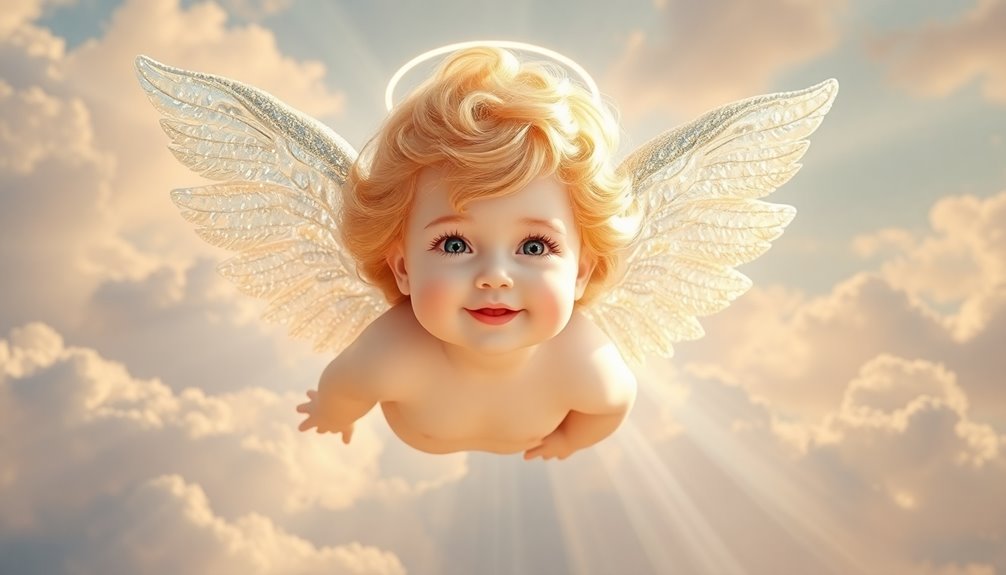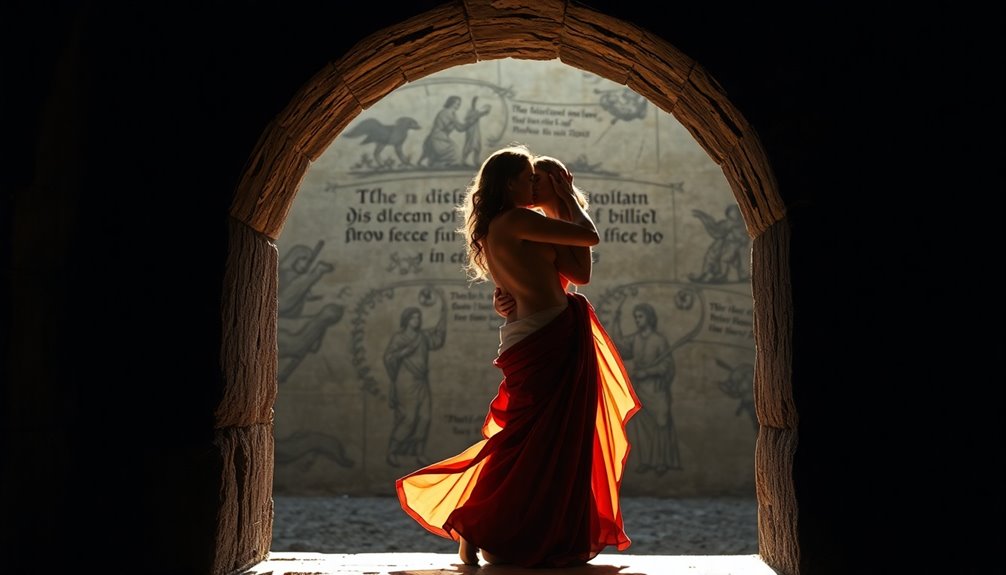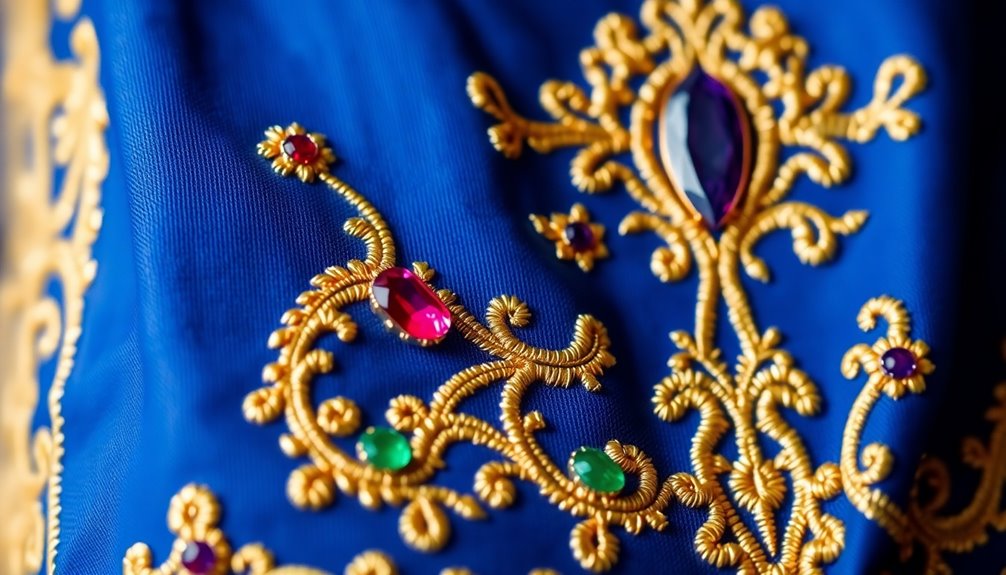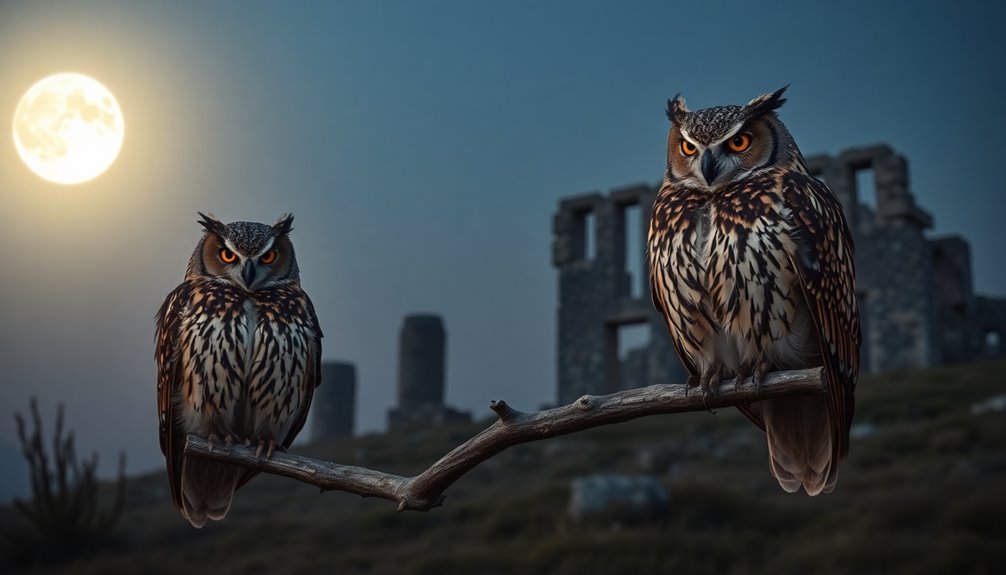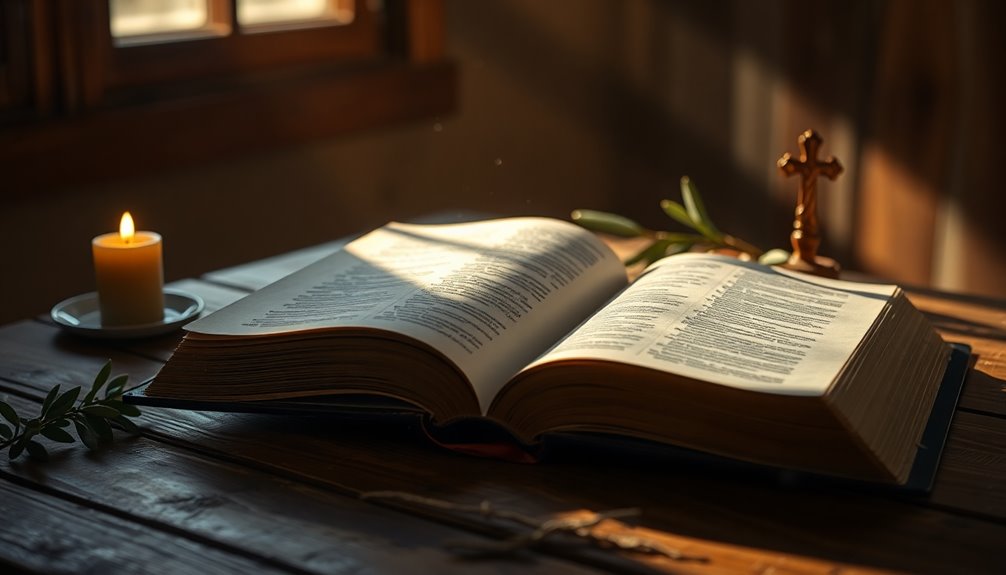Cherubim angels serve as powerful guardians, intertwining divine protection with God's presence. First mentioned in Genesis 3:24, they protect the Garden of Eden and later appear as majestic figures in Solomon's temple. These celestial beings symbolize the connection between heaven and earth, enhancing worship's reverence. Their unique forms and roles help convey God's glory and wisdom. Originally fearsome, they've evolved into symbols of innocence in art. Cherubim also inspire moral reflections and community service, guiding ethical living and compassion. If you explore further, you'll uncover even more fascinating aspects of cherubim's significance throughout history and culture.
Key Takeaways
- Cherubim are divine beings symbolizing protection and God's presence, first mentioned in Genesis 3:24.
- They serve as guardians of the throne of God and are depicted in the Ark of the Covenant.
- In Ezekiel 1:5-10, cherubim are described with hybrid forms, representing their role between heaven and earth.
- Cherubim influence moral guidance, encouraging ethical decision-making through their diverse symbolic representations.
- Their cultural significance has evolved from fearsome protectors to symbols of innocence and divine guardianship in art and literature.
Introduction
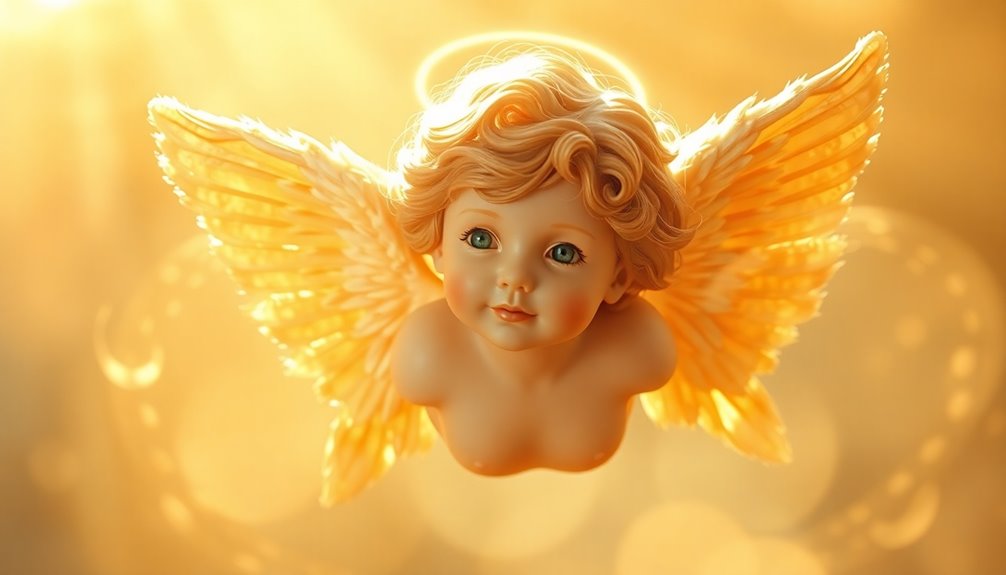
When you think of celestial beings, cherubim often come to mind as powerful symbols of divine protection and presence. These remarkable angels first appear in Genesis 3:24, where they guard the Garden of Eden, establishing a sacred space that only the worthy can access. Their role as protectors emphasizes the holiness associated with the presence of God.
In Ezekiel's vision, cherubim take on a striking form, depicted as hybrid creatures with four faces—man, lion, ox, and eagle—along with four wings. This multifaceted nature highlights their unique function as guardians of God's throne and messengers of His will.
You'll find their presence woven into the design of the Ark of the Covenant, further solidifying their role in facilitating the divine presence among the people.
Throughout Christian theology, cherubim symbolize not just divine protection but also the majesty of God. They often represent the intersection of heaven and earth, reminding us of the sacredness that surrounds our spiritual journey.
Understanding cherubim deepens your appreciation for the complex relationship between humanity and the divine.
Biblical Textual References
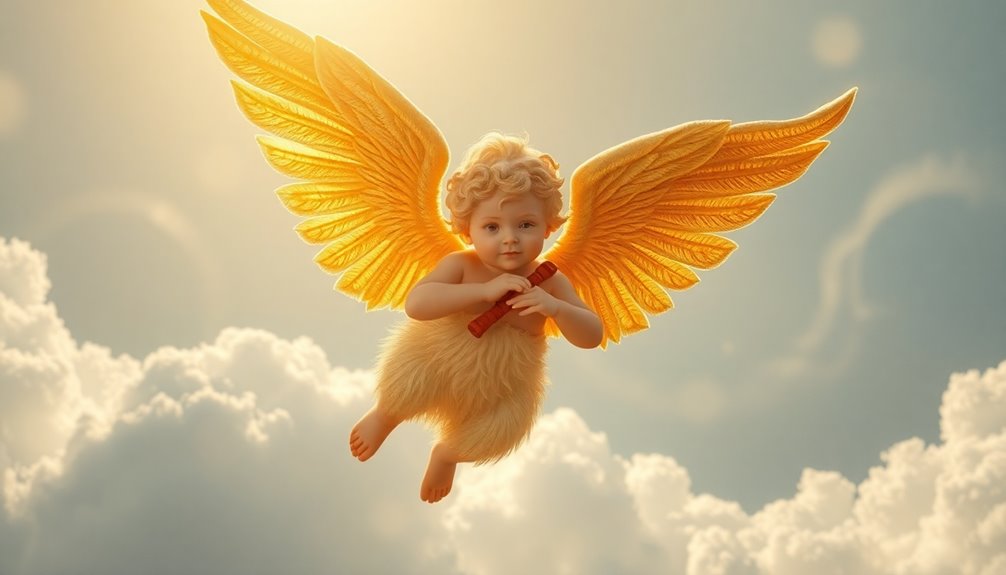
When you explore the biblical references to cherubim, you'll find both primary and secondary texts that highlight their significance.
Starting with Genesis and moving through to Revelation, these passages reveal their roles in guarding, worshiping, and symbolizing God's presence.
Let's look closer at these key scriptures to understand the depth of their representation in the Bible.
Primary Bible References
Cherubim pop up throughout the Bible, showcasing their significant role in both the earthly and heavenly realms. You first encounter cherubim in Genesis 3:24, where they guard the way to the Tree of Life in the Garden of Eden. This highlights their protective nature, marking the boundary of divine access.
In Exodus 25:18-22, God commands the creation of two gold cherubim on the mercy seat of the Ark of the Covenant, symbolizing His presence among His people. Their importance continues in 1 Kings 6:23-30, where large cherubim made of olive wood are placed in Solomon's temple, emphasizing their role as guardians of the divine sanctuary.
Ezekiel 1:5-10 takes you deeper into their description, revealing cherubim with four faces—man, lion, ox, and eagle—and four wings. This portrayal emphasizes their unique and powerful nature among angelic beings.
Finally, in Revelation 4:6-9, living creatures around God's throne share similarities with cherubim, reflecting their ongoing significance in the heavenly realm. Through these primary biblical references, you can see how cherubim serve as vital messengers and guardians of God's presence throughout scripture.
Secondary Bible References
The Bible's rich tapestry of references to cherubim paints a vivid picture of their roles beyond the primary passages.
You'll find that cherubim first appear in Genesis 3:24, where they guard the way to the tree of life with a flaming sword, symbolizing the protection of God's presence. Moving to Exodus 25:18-22, God instructs Moses to create two cherubim of gold atop the mercy seat of the Ark of the Covenant. This highlights their role as guardians of divine presence and mercy.
In Ezekiel 1:5-11, cherubim are described as four living creatures with four faces—man, lion, ox, and eagle—showing their majestic and hybrid nature.
You can also see their prominence in Solomon's temple, with two massive cherubim overshadowing the mercy seat, as noted in 1 Kings 6:23-28.
Finally, Revelation 4:6-9 brings cherubim full circle, depicting them around God's throne, continuously praising His holiness.
These secondary references enhance your understanding of cherubim, illustrating their vital roles as messengers and protectors in the heavenly hierarchy of angels in the Bible.
Ancient Near Eastern Symbolism
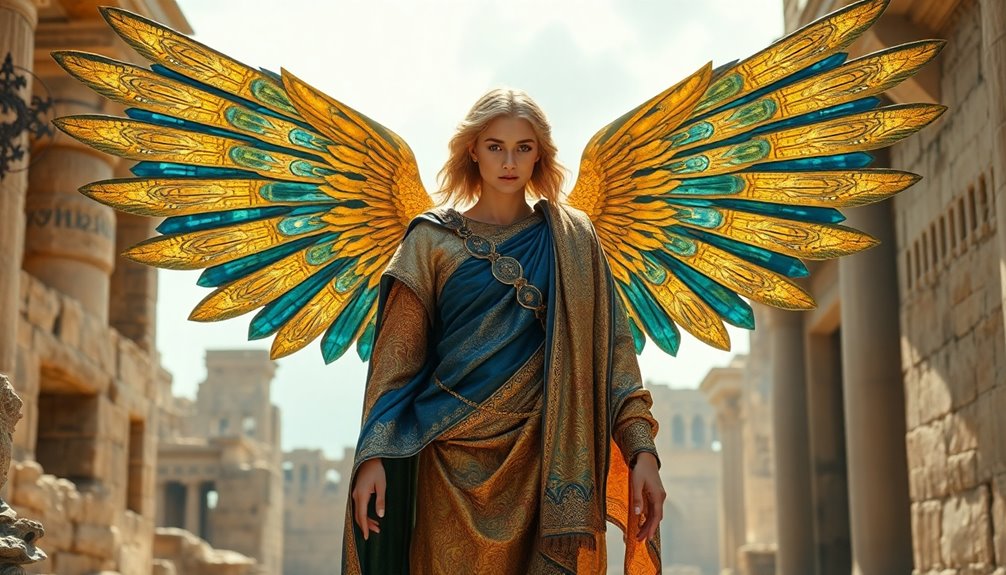
In Ancient Near Eastern cultures, cherubim symbolize the blend of divine and earthly realms through their hybrid forms, which often combine human and animal features.
These remarkable creatures, derived from the Akkadian term "karabu," embody a protective and benevolent nature, reflecting their role as guardians of sacred spaces. You'll notice that cherubim frequently appear in Mesopotamian art, particularly as lamassu—winged figures that safeguard entrances and divine locations.
In ancient temples, cherubim were strategically positioned to protect the divine presence, similar to their significance in the Israelite Tabernacle and Temple, where they adorned the Ark of the Covenant. This shows how cultures understood the importance of hybrid creatures in maintaining the sanctity of sacred areas.
Furthermore, texts such as the Epic of Gilgamesh reference these protective beings, confirming a shared cultural appreciation for their role in safeguarding what's divine.
Symbolism in Religious Texts

Throughout religious texts, cherubim symbolize divine protection and presence, often acting as guardians of sacred spaces. You'll find them prominently featured in the Garden of Eden, where they safeguard the entrance after humanity's expulsion (Genesis 3:24).
Similarly, in the design of the Ark of the Covenant, cherubim create a divine atmosphere, allowing for God's manifestation (Exodus 25:18-22).
In Ezekiel's vision, these spiritual beings take on an intricate form, described as hybrid creatures with four faces and wings, highlighting their unique role at the intersection of heaven and earth (Ezekiel 1:5-10).
They're more than mere symbols; they embody the glory of God and continuously praise His holiness, reinforcing their position as intermediaries between the divine and humanity (Revelation 4:6-9).
Their fierce protective nature reflects God's majesty and the sanctity of His presence, a concept revered in both Jewish and Christian traditions.
In Kabbalistic texts, cherubim represent attributes of divine wisdom and understanding, emphasizing their integral role in the spiritual hierarchy and in the ongoing relationship between God and creation.
Cherubim's Role in Worship
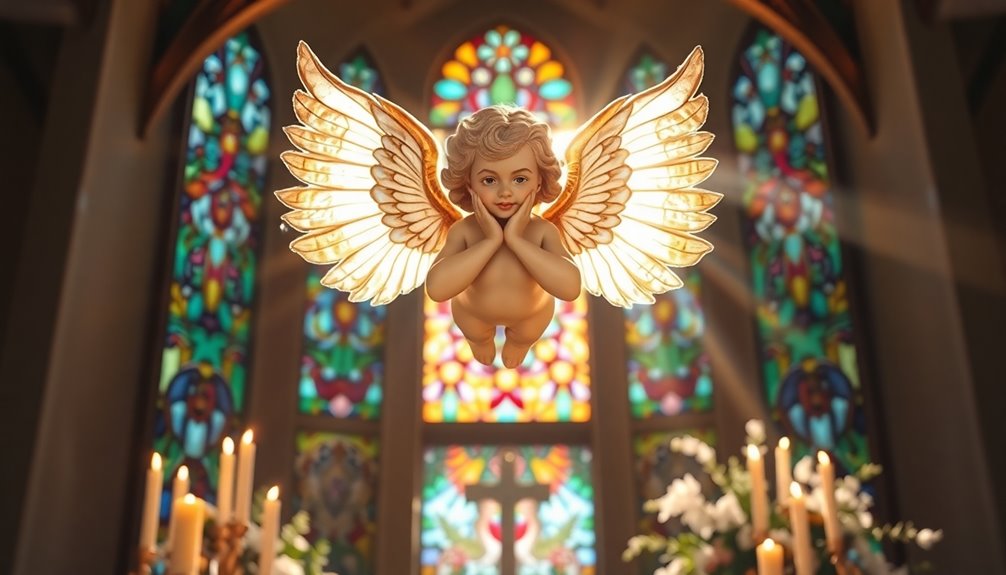
When you think about cherubim in worship, it's easy to get caught up in misconceptions and cultural interpretations.
These celestial beings not only guard sacred spaces but also enhance the atmosphere of reverence during worship.
Understanding their true role can deepen your appreciation for the divine presence they symbolize.
Debunk Common Cherub Misconceptions
While many people imagine cherubim as adorable, winged babies, this popular image couldn't be further from the truth. Biblical authors describe cherubim as hybrid creatures with multiple faces and wings, designed to evoke majesty and awe. These beings aren't just cute figures; they serve as guardians of sacred spaces, prominently featured in the tabernacle and the Ark of the Covenant, symbolizing God's presence and the boundary between the divine and human realms.
One common misconception is that cherubim are mere messengers like angels. In reality, their primary role is to act as guardians and symbols of divine favor. They emphasize God's protective nature and remind us of His authority throughout both Jewish and Christian traditions.
In worship, cherubim magnify God's holiness and power, continuously engaging in praise. They represent an essential aspect of the heavenly hierarchy, distinct from other angelic beings.
Recognizing the true nature of cherubim helps you appreciate their significant role in the divine narrative, moving beyond cute depictions to understand their profound purpose in worship and protection.
Cultural Interpretations of Cherubim
Cherubim play a vital role in worship, serving as powerful symbols of God's presence and majesty. In biblical contexts, cherubim act as guardians of the divine presence, emphasizing their importance as intermediaries between heaven and earth.
When you explore the significance of cherubim in the tabernacle and temple, you'll notice how they adorn the Ark of the Covenant, creating a sacred space where God's presence dwells.
Artistic representations of cherubim have evolved over time, reflecting various cultural influences. From ancient Near Eastern motifs to the chubby cherubs of the Renaissance, these images capture the essence of divine majesty in different eras.
In liturgical settings, cherubim remind worshippers of God's holiness and the protective atmosphere surrounding sacred spaces.
Furthermore, in Christian theology, cherubim are associated with the continuous praise of God, participating in the heavenly court where they magnify God's glory.
Their presence in worship not only highlights the divine attributes but also invites you to engage with the sacred, encouraging a deeper appreciation for the spiritual realm.
Cherubim truly enrich your worship experience, bridging the gap between the earthly and the divine.
Everyday Moral Guidance

When you face daily decisions, think about how cherubim symbolize the moral boundaries that guide your choices.
Engaging in community service initiatives can reflect your commitment to those values, reinforcing the importance of ethical living.
Cherubim in Daily Decisions
In your daily life, turning to the symbolism of cherubim can enrich your decision-making process. These celestial beings, as guardians of divine presence, remind you to seek spiritual guidance when faced with ethical dilemmas. By aligning your choices with higher moral standards, you create a foundation for integrity in your actions.
Consider the four faces of the cherubim—human, lion, ox, and eagle. Each represents a unique perspective, encouraging you to approach decision-making with a well-rounded mindset. When you encounter complex choices, think about how each viewpoint might influence your conclusions.
Engaging in reflection and prayer, much like the worship associated with cherubim, can offer clarity and insight. These practices help you navigate moral complexities with a sense of purpose.
Remember that cherubim act as intermediaries between God and humanity, inspiring you to seek divine wisdom in your everyday decisions. By doing so, you foster a deeper connection to a greater purpose, enhancing your moral compass.
Allow the symbolism of cherubim to guide your choices, and you'll find a more profound sense of fulfillment in your daily life.
Community Service Initiatives
Throughout your life, engaging in community service initiatives can provide essential moral guidance. By participating in acts of charity, you not only help those less fortunate but also cultivate a sense of compassion and responsibility within yourself. Programs like food drives, mentorships, and environmental clean-ups address immediate needs while teaching you the values of teamwork and civic duty.
When you volunteer, you're practicing ethical principles that are crucial for personal growth. Research shows that regular engagement in community service can improve your mental health and reduce stress levels. This hands-on approach allows you to apply values such as integrity, respect, and altruism in real-world scenarios, reinforcing your moral compass.
Moreover, community service reflects the teachings found in various religious traditions that advocate for supporting the marginalized. By helping others, you foster empathy and a deeper understanding of societal challenges. Each small act contributes to a larger change, reminding you that everyone has a role in building a compassionate community. Additionally, community service initiatives can promote emotional well-being in vulnerable populations, such as those affected by dementia or Parkinson's disease.
Embrace these opportunities, and you'll find that community service not only enriches the lives of others but also enhances your own.
Cherubim's Enduring Cultural Impact
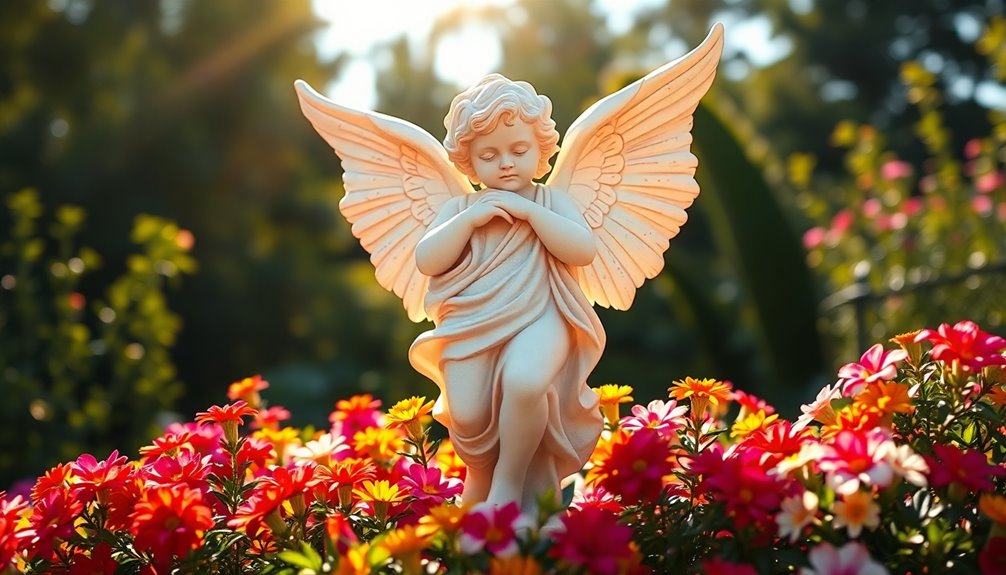
Cherubim have left an indelible mark on cultural expressions across centuries, transforming from their fearsome ancient roots into symbols of innocence and beauty in modern art. You might notice how these celestial beings evolved from intimidating hybrid creatures to the chubby, winged infants we recognize today, significantly shaping cultural perceptions of angels.
Throughout history, cherubim have graced various art forms, including paintings, sculptures, and literature, symbolizing divine protection and serving as reminders of God's presence. Their imagery often adorns sacred spaces, such as the Ark of the Covenant and temple structures, embedding them deeply into cultural and spiritual traditions.
In contemporary media, cherubim appear frequently, often detached from their original biblical context, yet still embodying aspects of guardianship and innocence. The term "cherub" has even been appropriated in various cultural contexts to evoke beauty and purity, diverging from its initial meanings tied to divine authority.
This transformation highlights how cherubim continue to inspire and influence our understanding of spirituality and protection, making them enduring symbols in both sacred and secular realms.
Additional Resources
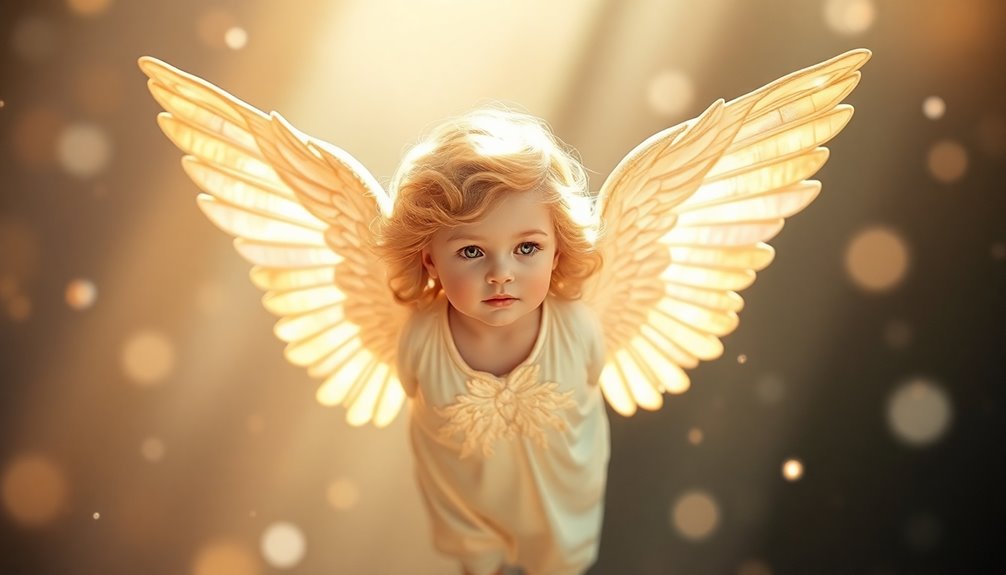
Exploring the rich symbolism and cultural significance of cherubim can deepen your understanding of these fascinating beings. To enhance your knowledge, consider delving into biblical texts that mention cherubim, such as Genesis 3:24, which describes their role in guarding the Garden of Eden, symbolizing divine protection.
Ezekiel's vision in Ezekiel 1:5-10 offers a striking depiction of cherubim with their four faces and wings, emphasizing their majestic presence.
For a broader perspective, look into Kabbalistic literature that discusses cherubim as mystical beings led by Kerubiel. This can provide insights into their complex roles in divine worship beyond traditional interpretations.
Art also plays a significant role in shaping perceptions of cherubim. Explore various artistic representations that contrast their powerful imagery with the more human-like depictions of angels.
Lastly, consider reading scholarly articles or watching documentaries that analyze the symbolism of cherubim in religious contexts and their impact on culture. These resources will enrich your appreciation for cherubim and their enduring legacy as protectors and symbols of God's presence.
Frequently Asked Questions
What Is a Cherubim Angel?
A cherubim is a unique celestial being often depicted in religious texts.
You'll find descriptions of them with multiple faces and wings, symbolizing their powerful presence. They serve as guardians of sacred spaces, protecting divine treasures and ensuring only the worthy can approach.
Their role emphasizes the importance of divine protection and worship, often being associated with blessings and the magnification of holiness in various traditions.
What Does God Say About Cherubim?
God describes cherubim as powerful beings tasked with guarding sacred spaces and representing His presence.
In Genesis, they protect the Garden of Eden, symbolizing divine boundaries.
Exodus details their creation for the Ark of the Covenant, showcasing their significance in worship.
Ezekiel portrays them as majestic creatures, emphasizing their multifaceted nature.
Are Cherubim Higher Than Angels?
Yes, cherubim are generally considered higher than regular angels in many religious traditions.
You'll find that they serve unique roles, often acting as guardians of sacred spaces, which sets them apart from typical angels. Their elevated status is reflected in various texts, indicating they hold a more complex and significant position in the celestial hierarchy.
Who Are the 4 Cherubim?
The four cherubim are fascinating beings described in biblical texts, particularly in Ezekiel. Each cherub has four faces: a man, a lion, an ox, and an eagle. This unique combination symbolizes various aspects of creation.
They possess four wings, using two for flying and two to cover themselves. These cherubim serve as guardians of God's throne, embodying the connection between the divine and earthly realms, and play vital roles in worship and divine authority.

